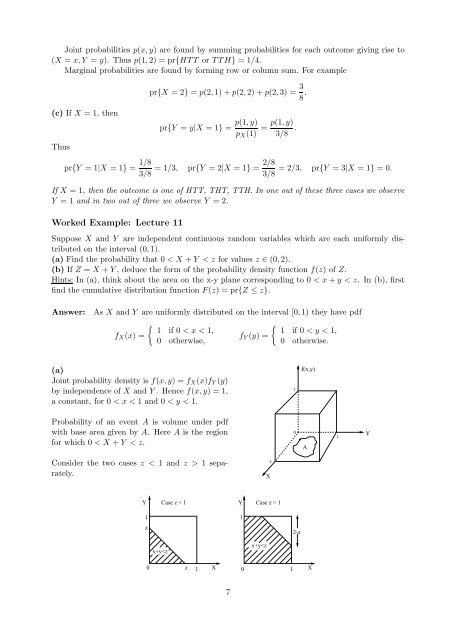MATH1725 Introduction to Statistics: Worked examples
MATH1725 Introduction to Statistics: Worked examples
MATH1725 Introduction to Statistics: Worked examples
Create successful ePaper yourself
Turn your PDF publications into a flip-book with our unique Google optimized e-Paper software.
Joint probabilities p(x,y) are found by summing probabilities for each outcome giving rise <strong>to</strong><br />
(X = x,Y = y). Thus p(1,2) = pr{HTT or TTH} = 1/4.<br />
Marginal probabilities are found by forming row or column sum. For example<br />
pr{X = 2} = p(2,1) + p(2,2) + p(2,3) = 3 8 .<br />
(c) If X = 1, then<br />
pr{Y = y|X = 1} = p(1,y)<br />
p X (1) = p(1,y)<br />
3/8 .<br />
Thus<br />
pr{Y = 1|X = 1} = 1/8<br />
2/8<br />
= 1/3, pr{Y = 2|X = 1} = = 2/3, pr{Y = 3|X = 1} = 0.<br />
3/8 3/8<br />
If X = 1, then the outcome is one of HTT, THT, TTH. In one out of these three cases we observe<br />
Y = 1 and in two out of three we observe Y = 2.<br />
<strong>Worked</strong> Example: Lecture 11<br />
Suppose X and Y are independent continuous random variables which are each uniformly distributed<br />
on the interval (0,1).<br />
(a) Find the probability that 0 < X + Y < z for values z ∈ (0,2).<br />
(b) If Z = X + Y , deduce the form of the probability density function f(z) of Z.<br />
Hints: In (a), think about the area on the x-y plane corresponding <strong>to</strong> 0 < x + y < z. In (b), first<br />
find the cumulative distribution function F(z) = pr{Z ≤ z}.<br />
Answer: As X and Y are uniformly distributed on the interval [0,1) they have pdf<br />
f X (x) =<br />
{ 1 if 0 < x < 1,<br />
0 otherwise,<br />
f Y (y) =<br />
{ 1 if 0 < y < 1,<br />
0 otherwise.<br />
(a)<br />
Joint probability density is f(x,y) = f X (x)f Y (y)<br />
by independence of X and Y . Hence f(x,y) = 1,<br />
a constant, for 0 < x < 1 and 0 < y < 1.<br />
1<br />
f(x,y)<br />
Probability of an event A is volume under pdf<br />
with base area given by A. Here A is the region<br />
for which 0 < X + Y < z.<br />
0<br />
A<br />
1<br />
Y<br />
Consider the two cases z < 1 and z > 1 separately.<br />
1<br />
X<br />
Y<br />
1<br />
Case z < 1 Y Case z > 1<br />
1<br />
z<br />
2-z<br />
x+y

















